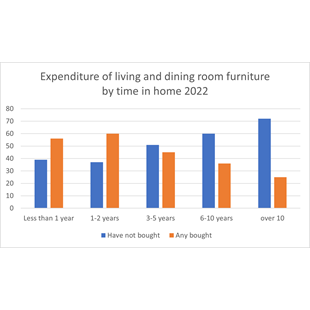Design as Wellbeing
- Retailers can learn from the 2011-2014 income squeeze. Spending fell twice, in both 2010 and 2012. Within the market, big-ticket sales were the hardest hit, while demand was also impacted by the significant slowdown in the housing sector and major renovations.
- Data from the furniture category suggests that consumers are most likely to buy big-tickets items 1-2 years after moving rather than straight away, so there could be a delayed effect after the recent housing boom for more expensive items.
- Mintel’s ‘Aesthetic Effect’ trend notes that aesthetics can change our emotional state with the associated cognitive processing evoking feelings of affection, patience and pleasure and thus promoting wellbeing. Building such benefits into furniture offers a chance to deliver such benefits to a group of consumers who may not be aware of what new [..] designs can deliver.
- The other Mintel trend of ‘Me’ Mentality: “People are emerging from the pandemic eager to refocus on themselves.” Will support these efforts.
- Another Mintel trend worth exploring is the idea of ‘Intentional Spending’ which suggests that factors like flexibility, durability and sustainability will play increasingly important roles in consumers’ value equation. Whilst it’s already true to a large extent, over the next 5 years it will be increasingly obvious that what people wear, eat and drive won’t just signal status, but will be a detailed account of their attitudes and beliefs.
 |
 |
Relevant Clients
English Heritage

